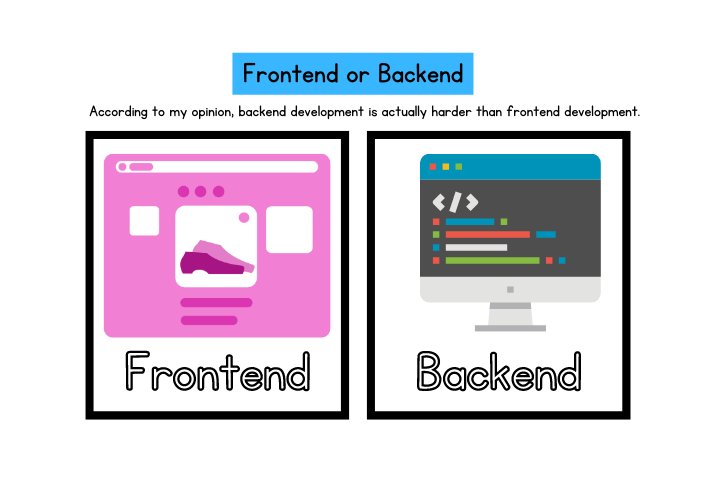Which is More Difficult, Frontend or Backend Development?
The debate between frontend and backend developers has been going on for years. According to my opinion, backend development is actually harder than frontend development. Because you have to have the knowledge and stable coding skill for scalability, security, and performance. There are pros and cons to each side, but ultimately it depends on what you’re looking for in a career.

What are Frontend and Backend Development?
Frontend Development
Frontend development is the practice of building the user interface and experience for a website or application. In other words, if you’re a front-end developer, your job is to make sure that the user can see and interact with the site or app the way it was intended. This generally involves working with languages like HTML, CSS, and JavaScript.
Backend Development
Backend development, on the other hand, is responsible for powering the functionality of the site or app. This means working with databases, managing user data, handling security, and everything else that happens behind the scenes. Backend developers usually work with languages like PHP, Ruby on Rails, and Python.
Why Backend Development is Harder?
You have to worry about scalability and performance
When you’re working on the front end, you can get away with things being a little slow and clunky because the user doesn’t have to wait for the page to load before they can use it. But when you’re working on the back end, every millisecond counts.
Users are impatient and they won’t tolerate a slow website or app. As a result, you have to be very careful about things like scalability and performance when you’re working on the back end. This can be a challenge, especially if you’re not experienced with optimizing code for performance.
You have to be good at both coding and system design
When you’re working on the front end, you can get away with being just a good coder. But when you’re working on the back end, you have to be good at both coding and system design. This is because the back end is responsible for everything from storing data to processing requests to sending responses back to the client.
As a result, you need to be able to design efficient systems as well as write code that is clean and easy to maintain. This can be a challenge, especially if you’re not experienced with designing systems.
Your application needs to be secure
When you’re working on the front end, your main concern is usually making sure that the user interface is easy to use and looks good. But when you’re working on the back end, your main concern is security. This is because the back end is responsible for storing sensitive data like passwords and credit card numbers.
As a result, you need to be very careful about things like SQL injection attacks and cross-site scripting attacks. This can be a challenge, especially if you’re not experienced with web security.
What is Hard about Frontend Development?
There are quite a few challenges that frontend developers face daily. From having to learn new technologies such as Sass or ReactJS, to dealing with compatibility issues between different libraries and frameworks.
CSS pre-processors
One of the first things that any frontend developer will need to learn is how to use a CSS pre-processor. A CSS pre-processor is a language that extends the capabilities of CSS, making it easier and more efficient to write CSS code. The most popular CSS pre-processors are Less and Sass.
While learning a CSS pre-processor may not seem like a big deal at first, it can actually be quite challenging. First of all, there is a bit of a learning curve associated with them. It can take some time to get used to the syntax and features of a CSS pre-processor. Additionally, because they are not native CSS, they can sometimes be difficult to debug if something goes wrong.
CSS frameworks
Another challenge that front-end developers face is working with CSS frameworks. A CSS framework is a collection of predefined CSS styles that can be used to style a website. The most popular CSS frameworks are Bootstrap and Foundation.
CSS frameworks can be extremely helpful when it comes to quickly style a website. However, they can also be quite limiting. This is because you are restricted to using only the styles that are defined in the framework. If you want to deviate from the framework in any way, you’ll often find yourself having to write custom CSS code to override the framework styles. This can be quite time-consuming and frustrating.
JavaScript libraries and frameworks
In addition to HTML and CSS, front-end developers also need to have at least some basic knowledge of JavaScript in order to build interactive websites. JavaScript libraries and frameworks are one of the most popular tools for doing this. Some of the most popular JavaScript libraries and frameworks are jQuery, AngularJS, and ReactJS.
Just like with CSS frameworks, JavaScript libraries and frameworks can be both helpful and limiting at the same time. They can help you quickly build complex interactive features without having to write hundreds of lines of code from scratch. However, they can also make your code more difficult to debug because you’re relying on third-party code that you may not be familiar with.
Additionally, if you want to use features from multiple different libraries or frameworks, you run the risk of running into compatibility issues between them.